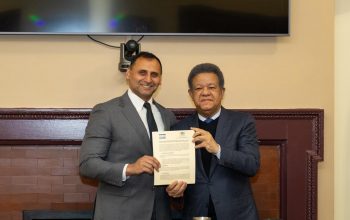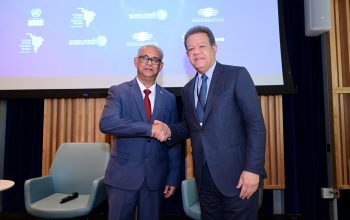news
“The PLD, Twenty Years In”, an article by Dr. Leonel Fernández
August 22, 2016
Twenty years ago, in 1996, the Dominican Liberation Party (PLD) took power for the first time. Back then it represented little more than an enigma to voters – a question mark, a mystery.
No one knew exactly what would emerge from government under the Purple Party, especially since almost all its members lacked experience in public office. Furthermore, during the years it was coming together during the Cold War, the PLD had come behind national liberation
as a strategic objective, and its historical leader, the professor Juan Bosch, had deployed Marxism as an analytic tool in interpreting Dominican society.
There were thus great expectations surrounding the ascent to power of a new generation that had taken as its goal the building of a new path to economic reform, social change, and institutional transformation to support those at all levels of national life.
Since then the PLD has become the most
successful political organization in the history of the Dominican Republic. It has won the presidency five times, the last four times consecutively, and on all occasions with more than 50 percent of the votes cast.
In 1996 the PLD was represented by just one senator and four deputies. Over the last 20 years it’s reached 31 senators and 106 members in the lower chamber. The same trend has occurred with mayors and governors, which have multiplied in significant
numbers.
Obviously the electoral success of the PLD is owed to the fact that under its various administrations it has notably contributed to accelerating wealth generation capacity, growing prosperity, and the promotion of social welfare.
With the PLD in the National Palace, public enterprises that had been on the brink of bankruptcy were capitalized; the national economy was opened; the banking, transport, and telecoms sectors grew; and the huge new
commercial centers and residential towers that today adorn the nation’s cityscapes were built.
In short, under the past four PLD administrations, the Dominican Republic has undergone a period of peace and stability, of enormous change and progress, and of notable flourishing. Some call it the Dominican miracle.
The Pld’s Achievements
During the past 16 years of PLD government, GDP grew from $18 billion
in 1996 to $62 billion in 2012, to $68 billion in 2015. While GDP per capita once stood at just $2,452, it’s now nearly tripled to $6,755. Foreign direct investment was just $96 million in 1996, but by 2012 it had reached $3.142 billion.
Capital spending shot from 12 billion to 86 billion pesos. Social spending, in turn, moved from an anemic 10 billion pesos to the astronomical sum of 249 billion pesos. Net international reserves in 1996 amounted to a meager
$255 million, compared to their current level of $4.8 billion.
The average annual growth rate has been near 7 percent, some years topping 10 and 11 percent. Inflation – for years a national tragedy – has stayed low.
Monetary policy aimed at achieving high liquidity levels. The quantity of pesos in circulation in the economy increased. Consumer purchasing power increased to unprecedented levels.
The exchange rate remained
under control. A great amount of foreign currency flowed into the country from the increase in exports, tourism, remittances, and the establishment of free zones.
In 1996, at the end of his last term, president Joaquín Balaguer stated that he had left the Dominican economy like a plane on the runway, with engines running, ready for takeoff. The PLD took him at his word and managed to not only set the plane of Dominican progress into flight, but send it up thousands of
feet in altitude.
This navigation capacity of the PLD governments has translated into prosperity and wellbeing for our people. The poverty rate has decreased drastically. Thousands of jobs have been generated. The maternal and infant mortality rates have decreased, and diseases such as malaria, cholera, and tuberculosis have practically disappeared.
Social security coverage went from 38,000 to 5 million affiliates. School breakfasts increased to more
than a million rations daily. Gas and electricity consumption was subsidized for the most vulnerable families. The social plan of the Presidency was activated, involving even a project for cheap mobile eateries.
Infrastructure and Institutions
If the PLD administrations have been remarkable for anything, it’s been, among other factors, for infrastructure development. Not a single corner of the national territory has been untouched
by public works – bridges, highways, tunnels, and overpasses – undertaken by Purple Party governments.
Dozens of aqueducts have been built in various communities, quenching the thirst that plagued many of their citizens. Many water treatment plants and hydroelectric dams have been raised around the country.
It was during the PLD administrations that the Autonomous University of Santo Domingo (UASD) achieved its greatest transformation. The Alma
Mater was remodeled and the Pedro Mir Library built. The administration towers and rectory, along with a modern park and spacious cafeteria, were also constructed.
In addition, the campuses of the eight regional extensions were also established in Bonao, Santiago, Puerto Plata, Mao, Nagua, San Juan de la Maguana, Barahona, and Higüey.
Other public works under PLD administrations include the San Luis Technical Institute (the country’s first
community college); the Community Technical Centers scattered through the provinces; the Technological Institute of the Americas (ITLA); and the Santo Domingo Cybernetic Park.
There was also the Ciudad de la Salud and the public housing complexes at Boca Cachón, Nueva Barquita, Ciudad Juan Bosch, and Villa Liberación, as well as the Santo Domingo beltway.
During its 16 years of governance, the PLD has been recognized for having benefited more than a
million low-income citizens with the Solidarity Card. For having supported the poorest with the People’s Pharmacies. For having promoted the International Book Fair and the Student Merit Recognition. For having granted thousands of study-abroad scholarships to students from low-income families.
The Purple Party administrations are also recognized for having oriented the country in a respectable position on the international scene and more intensively integrated
it with the neighboring countries of the Caribbean and Central America.
The party has deepened this role through the country’s active presence in the United Nations and its presidency of the African, Caribbean, and Pacific Group of States (ACP) and the Community of Latin American and Caribbean States (CELAC), as well as through the reestablishment of diplomatic relations with Cuba, the recognition of the right of Palestine to independent statehood while
respecting the security of the people of Israel, and our solidarity with Haiti in its great moment of tragedy.
The PLD has been the party of the National Dialogue and the Governance Pacts, of the modernization of the Dominican state, of the professionalization of the judiciary, and of the building of institutions to foster transparency.
Despite these achievements, no attempt has been made to claim that PLD administrations have been a mirror of
perfection. None of that. Dominican society still faces great challenges ahead. Like everything in life, PLD administrations are weighed on a balance, with the positives on one side and the negatives on the other. What’s clear, though, is that the pluses outweigh the minuses, to make for an overall strong positive result for the benefit of the Dominican people.
Finally, as the seal of identity of the PLD administrations, there is the Santo Domingo metro, which
now transports some 200,000 people per day and 65 million people per year.
In short, twenty years in, the Dominican Liberation Party has established itself as the architect of the progress and wellbeing of the Dominican people.
Related link:
http://leonelfernandez.com/articulos/el-pld-veinte-anos-despues/






